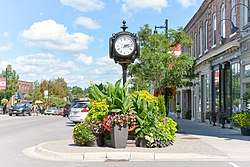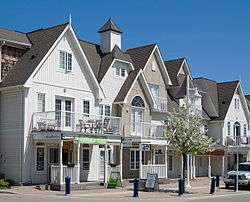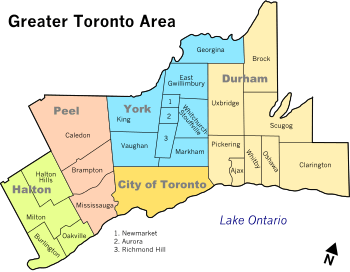Regional Municipality of Durham
The Regional Municipality of Durham, informally referred to as Durham Region, is a regional municipality in Southern Ontario, Canada. Located east of Toronto and the Regional Municipality of York, Durham forms the east-end of the Greater Toronto Area and the core part of the Golden Horseshoe region. It has an area of approximately 2,500 km2 (970 sq mi). The regional government is headquartered in Whitby.
Durham Region | |
|---|---|
Regional municipality (upper-tier) | |
| Regional Municipality of Durham | |
 Seal | |
| Motto(s): "A Great Place to Grow" | |
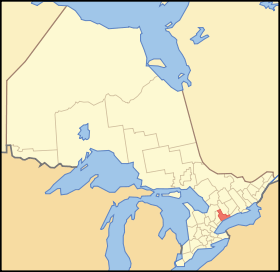 Map showing Durham Region's location in Ontario | |
| Coordinates: 43°55′N 78°56′W | |
| Country | Canada |
| Province | Ontario |
| Established | 1792 (County) 1974 (Regional Municipality) |
| Seat | Whitby |
| Government | |
| • Chair Governing Body | John Henry Durham Regional Council |
| Area (2016)[1] | |
| • Land | 2,523.80 km2 (974.44 sq mi) |
| Elevation | 91.3 m (299.5 ft) |
| Population | |
| • Total | 645,862 |
| • Density | 255.9/km2 (663/sq mi) |
| Time zone | UTC−05:00 (EST) |
| • Summer (DST) | UTC−04:00 (EDT) |
| Website | www.durham.ca |
The southern portion of the region, on Lake Ontario is primarily suburban in nature, forming the eastern end of the 905 area code belt of suburbs around Toronto. The northern area comprises rural areas and small towns. The city of Pickering, town of Ajax and the township of Uxbridge are part of the Toronto Census Metropolitan Area, while the communities of Oshawa, Whitby, and Clarington comprise the Oshawa Census Metropolitan Area.
Administrative divisions
Durham Region consists of the following municipalities (in order of population):
| Municipality | 2016 Population[2] |
|---|---|
| City of Oshawa | 159,458 |
| Town of Whitby | 128,377 |
| Town of Ajax | 119,677 |
| Municipality of Clarington | 92,013 |
| City of Pickering | 91,771 |
| Township of Scugog | 21,617 |
| Township of Uxbridge | 21,176 |
| Township of Brock | 11,642 |
It also contains one First Nations reserve: Mississaugas of Scugog Island First Nation.
Local government
History
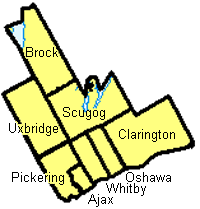
The Region of Durham was established in 1974 as one of several new regional governments in the Province of Ontario, primarily in fast-growing urban and suburban areas. It encompasses areas that had been part of Ontario County and the United Counties of Northumberland and Durham, and was the culmination of a series of studies into municipal governance in the "Oshawa-Centred Region" that had begun in the late 1960s.
The boundaries of the region were different from what had been anticipated and announced in late 1972. For example, it was widely expected that Pickering would be annexed to Metropolitan Toronto, which residents had supported in a ballot question. In addition, the region was proposed to extend further east to include Hope Township and the town of Port Hope, and did not include the northern townships of Scott, Brock and Thorah.
Climate
Under the Köppen climate classification, the Durham Region has a humid continental climate (Köppen Dfb).
| Climate data for Bowmanville (Clarington) (1981−2010) | |||||||||||||
|---|---|---|---|---|---|---|---|---|---|---|---|---|---|
| Month | Jan | Feb | Mar | Apr | May | Jun | Jul | Aug | Sep | Oct | Nov | Dec | Year |
| Record high °C (°F) | 13.0 (55.4) |
12.5 (54.5) |
21.5 (70.7) |
29.0 (84.2) |
33.0 (91.4) |
33.5 (92.3) |
36.0 (96.8) |
35.0 (95.0) |
32.2 (90.0) |
26.0 (78.8) |
21.1 (70.0) |
17.5 (63.5) |
36.0 (96.8) |
| Average high °C (°F) | −1.4 (29.5) |
0.0 (32.0) |
4.3 (39.7) |
11.3 (52.3) |
18.0 (64.4) |
23.1 (73.6) |
25.8 (78.4) |
24.8 (76.6) |
20.4 (68.7) |
13.7 (56.7) |
7.2 (45.0) |
1.6 (34.9) |
12.4 (54.3) |
| Daily mean °C (°F) | −5.6 (21.9) |
−4.4 (24.1) |
−0.2 (31.6) |
6.4 (43.5) |
12.4 (54.3) |
17.5 (63.5) |
20.0 (68.0) |
19.2 (66.6) |
15.0 (59.0) |
8.7 (47.7) |
3.4 (38.1) |
−2.2 (28.0) |
7.5 (45.5) |
| Average low °C (°F) | −9.9 (14.2) |
−8.8 (16.2) |
−4.6 (23.7) |
1.5 (34.7) |
6.8 (44.2) |
11.8 (53.2) |
14.3 (57.7) |
13.5 (56.3) |
9.5 (49.1) |
3.6 (38.5) |
−0.4 (31.3) |
−6.0 (21.2) |
2.6 (36.7) |
| Record low °C (°F) | −34.0 (−29.2) |
−30.0 (−22.0) |
−26.0 (−14.8) |
−14.4 (6.1) |
−5.0 (23.0) |
−1.0 (30.2) |
2.8 (37.0) |
−0.5 (31.1) |
−3.3 (26.1) |
−8.3 (17.1) |
−17.8 (0.0) |
−34.5 (−30.1) |
−34.5 (−30.1) |
| Average precipitation mm (inches) | 63.1 (2.48) |
50.5 (1.99) |
55.0 (2.17) |
70.6 (2.78) |
75.9 (2.99) |
83.8 (3.30) |
63.2 (2.49) |
78.1 (3.07) |
98.7 (3.89) |
70.8 (2.79) |
88.6 (3.49) |
68.1 (2.68) |
866.5 (34.11) |
| Average rainfall mm (inches) | 32.2 (1.27) |
32.8 (1.29) |
41.0 (1.61) |
68.0 (2.68) |
75.9 (2.99) |
83.8 (3.30) |
63.2 (2.49) |
78.1 (3.07) |
98.7 (3.89) |
70.6 (2.78) |
83.1 (3.27) |
46.1 (1.81) |
773.3 (30.44) |
| Average snowfall cm (inches) | 31.0 (12.2) |
17.7 (7.0) |
14.1 (5.6) |
2.6 (1.0) |
0.0 (0.0) |
0.0 (0.0) |
0.0 (0.0) |
0.0 (0.0) |
0.0 (0.0) |
0.1 (0.0) |
5.6 (2.2) |
22.0 (8.7) |
93.1 (36.7) |
| Average precipitation days (≥ 0.2 mm) | 12.5 | 10.8 | 11.2 | 12.5 | 12.2 | 12.0 | 10.4 | 11.5 | 13.0 | 13.0 | 14.3 | 13.0 | 146.4 |
| Average rainy days (≥ 0.2 mm) | 5.5 | 5.3 | 8.0 | 11.8 | 12.2 | 12.0 | 10.4 | 11.5 | 13.0 | 13.0 | 12.7 | 7.4 | 122.7 |
| Average snowy days (≥ 0.2 cm) | 7.8 | 6.3 | 4.0 | 1.1 | 0.0 | 0.0 | 0.0 | 0.0 | 0.0 | 0.1 | 2.1 | 6.5 | 27.9 |
| Source: Environment Canada[3] | |||||||||||||
| Climate data for Oshawa (1981−2010) | |||||||||||||
|---|---|---|---|---|---|---|---|---|---|---|---|---|---|
| Month | Jan | Feb | Mar | Apr | May | Jun | Jul | Aug | Sep | Oct | Nov | Dec | Year |
| Record high °C (°F) | 14.0 (57.2) |
11.5 (52.7) |
23.5 (74.3) |
29.5 (85.1) |
32.0 (89.6) |
34.5 (94.1) |
36.5 (97.7) |
36.0 (96.8) |
31.5 (88.7) |
24.4 (75.9) |
21.1 (70.0) |
16.5 (61.7) |
36.5 (97.7) |
| Average high °C (°F) | −1.1 (30.0) |
0.1 (32.2) |
4.2 (39.6) |
10.8 (51.4) |
16.9 (62.4) |
22.3 (72.1) |
25.1 (77.2) |
24.3 (75.7) |
20.2 (68.4) |
13.3 (55.9) |
7.4 (45.3) |
2.1 (35.8) |
12.1 (53.8) |
| Daily mean °C (°F) | −4.8 (23.4) |
−3.6 (25.5) |
0.4 (32.7) |
6.6 (43.9) |
12.3 (54.1) |
17.6 (63.7) |
20.6 (69.1) |
20.0 (68.0) |
15.9 (60.6) |
9.5 (49.1) |
4.2 (39.6) |
−1.2 (29.8) |
8.1 (46.6) |
| Average low °C (°F) | −8.5 (16.7) |
−7.3 (18.9) |
−3.5 (25.7) |
2.5 (36.5) |
7.7 (45.9) |
12.9 (55.2) |
15.9 (60.6) |
15.6 (60.1) |
11.7 (53.1) |
5.6 (42.1) |
1.0 (33.8) |
−4.4 (24.1) |
4.1 (39.4) |
| Record low °C (°F) | −30.5 (−22.9) |
−27 (−17) |
−24 (−11) |
−13.3 (8.1) |
−2.8 (27.0) |
1.1 (34.0) |
6.0 (42.8) |
3.0 (37.4) |
−0.6 (30.9) |
−7.8 (18.0) |
−13 (9) |
−29 (−20) |
−30.5 (−22.9) |
| Average precipitation mm (inches) | 65.6 (2.58) |
56.6 (2.23) |
54.2 (2.13) |
72.7 (2.86) |
78.9 (3.11) |
73.9 (2.91) |
73.1 (2.88) |
77.4 (3.05) |
94.0 (3.70) |
70.1 (2.76) |
84.8 (3.34) |
70.7 (2.78) |
871.9 (34.33) |
| Average rainfall mm (inches) | 30.0 (1.18) |
31.7 (1.25) |
40.7 (1.60) |
70.6 (2.78) |
78.9 (3.11) |
73.9 (2.91) |
73.1 (2.88) |
77.4 (3.05) |
94.0 (3.70) |
70.0 (2.76) |
80.0 (3.15) |
45.8 (1.80) |
766.1 (30.16) |
| Average snowfall cm (inches) | 35.6 (14.0) |
24.9 (9.8) |
13.5 (5.3) |
2.0 (0.8) |
0.0 (0.0) |
0.0 (0.0) |
0.0 (0.0) |
0.0 (0.0) |
0.0 (0.0) |
0.1 (0.0) |
4.7 (1.9) |
24.9 (9.8) |
105.8 (41.7) |
| Average precipitation days (≥ 0.2 mm) | 13.6 | 10.4 | 11.0 | 12.8 | 12.8 | 10.8 | 10.6 | 11.2 | 12.1 | 13.5 | 14.4 | 12.6 | 145.7 |
| Average rainy days (≥ 0.2 mm) | 5.7 | 5.0 | 7.9 | 12.4 | 12.8 | 10.8 | 10.6 | 11.2 | 12.1 | 13.4 | 13.3 | 7.5 | 122.7 |
| Average snowy days (≥ 0.2 cm) | 8.7 | 6.3 | 3.8 | 0.85 | 0.0 | 0.0 | 0.0 | 0.0 | 0.0 | 0.08 | 1.8 | 5.9 | 27.5 |
| Source: Environment Canada[4] | |||||||||||||
Demographics
| Year | Pop. | ±% |
|---|---|---|
| 1991 | 409,070 | — |
| 1996 | 458,616 | +12.1% |
| 2001 | 506,901 | +10.5% |
| 2006 | 561,258 | +10.7% |
| 2011 | 608,124 | +8.4% |
| 2016 | 645,862 | +6.2% |
| 2016[5], 2011[6], 2006[7], earlier[8][8][9] | ||
The Regional Municipality of Durham is predominately white representing 70.1% of the population. There is also a large population of South Asians totaling 8.6% of the population and Black Canadians totaling 8.0% of the population. Smaller ethnic groups include Filipino with 2.3% of the population, Aboriginal with 2.0%, Chinese with 1.9%, Mixed visible minority with 1.3%, Latin American with 1.0% and West Asian (Middle Eastern) with 1.0%.
Services
The regional government, within its geographic area, has sole responsibility for the following:
- Durham Regional Police Service provides local policing for all municipalities.
- The Ontario Provincial Police patrol provincial highways
- Durham Region Transit provides public transit service
- Main roads, traffic lights and controls
- Strategic land use planning
- Subdivision and condominium approval
- Water supply and distribution
- Sewage collection and treatment
- Collection of recyclable materials
- Waste collection, except in Whitby and Oshawa
- Waste disposal
- Public health and social services
The region also provides services in:
Local municipalities have responsibility for:
- Local planning
- Local streets and sidewalks
- Fire protection
- Parks and recreation
- Tax collection
- Building inspection and permits
- Public libraries
- Licensing
- Waste collection in Whitby and Oshawa
Economy
With a current population of 645,000, the population is expected to exceed one million by 2041.[10] Of considerable potential impact to the future of the economy in Durham Region is the proposed federal airport in north Pickering. The federal government acquired 18,600 acres of land in Pickering under Prime Minister Pierre Trudeau in 1972 for the construction of a future airport. However, the project has remained in limbo since and much of the land has been leased for farming.[11] In January 2018, a report released by Urban Strategies, Inc. indicated that the Pickering airport lands provide the best opportunity to meet the growing demand for air travel and goods movement in the Greater Toronto Area, demand that Toronto Pearson airport will eventually be unable to accommodate.[12]
As of December 2016, Durham Region had over 250 energy, environment and engineering (EN3) related businesses that employed over 11,000 individuals, making Durham Region the top employer of EN3 professionals in the Greater Toronto and Hamiton Area (GTHA).[13]
Durham Region's agricultural sector is one of the largest primary goods-producing sectors in the region.[14] The agriculture sector is supported by local organizations such as Durham Farm Fresh who assist in the marketing, promotion, and advocacy for local food.
In 2018, the Canadian motion picture and video exhibition industries generated $1.9 billion in operating revenue, marking a 5.7% increase from 2016. The majority of this operating revenue was contributed by Ontario, at 42.7%.[15] The film industry is active and growing[16] in Durham Region, due to increasing demands for locations and talent across Ontario. In June of 2015, a major film studio development was announced in Pickering.[17]
The innovative technology sector is emerging in Durham Region, supported by a Regional Innovation Centre in Oshawa and a technology accelerator in Whitby.[18] Whitby is the location of the headquarters of 360 Insights a significant employer in Durham Region.[19]
83 percent of Durham residents over 18 have a certificate, diploma or degree. [20]Youth unemployment is a major issue in the region: at 23% by the Durham Workforce Authority in 2013, it is 17% higher than the provincial average. Emerging employment sectors in Durham Region include sustainable energy, local food production, bio-sciences, next-generation automotive, logistics, advanced manufacturing, construction, and technology.[21]
Major employers in Durham Region include General Motors of Canada, Ontario Power Generation, Lakeridge Health, Durham District School Board, Durham College, the Ontario Ministry of Finance, Minacs Worldwide, TDS Automotive, and University of Ontario Institute of Technology.[22]
Manufacturing and Energy Industries
Durham Region is a major centre of the automotive industry in Canada. Oshawa is the Canadian headquarters of General Motors and home of what was once GM's largest plant in North America. In addition, the Canadian headquarters of Volkswagen is located in the region, BMW was located in the region until moving to Richmond Hill in 2010. The worldwide recession and spike in oil prices resulted in large-scale layoffs at GM beginning in 2008, along with the closure of the Oshawa Truck plant in 2009. This dramatically reduced employment levels at GM, and also resulted in significant employment losses and closures in the auto parts industry. On November 26, 2018, General Motors announced that no future product would be allotted to Oshawa beyond 2019 and that manufacturing operations would cease in December 2019. In October 2019, General Motors announced the construction of a 55-acre autonomous vehicle test track in Oshawa to be named the Canadian Technical Centre (CTC) McLaughlin Advanced Technology Track.[23]
Durham Region is the Clean Energy Capital of Canada.[24] Ontario Power Generation (OPG) is the largest employer in the region. OPG is Canada's largest owner of nuclear power plants with responsibility for operating the Pickering A, B, and Darlington nuclear generating stations, all of which are located in Durham Region. In June of 2019 OPG announced it would be building a new corporate campus in Durham Region, in the Municipality of Clarington, by 2024.[25]Ontario Tech University offers the first accredited program of its kind in Canada with an undergraduate degree program in Nuclear Engineering. It is also a leader is Energy Systems and Nuclear Science programs. The Clean Energy Research Lab (CERL) is a facility focused on pioneering clean energy research.[26]
Shopping
Major shopping centres located in Durham Region include:
- First Pickering Place (Pickering)
- Oshawa Power Centre (Oshawa)
- Oshawa Centre (Oshawa)
- Pickering Town Centre (Pickering)
- Thickson Centre (Whitby)
- Rio-Can Durham Centre (Ajax)
- The Bowmanville Mall (Bowmanville)
- The Whitby Mall (Whitby)
- Durham Live (Pickering- Under Construction)
Transportation
400-series freeways




- As of December 2019 Highway 407 extends to the Highway 35 / 115 in the east.
Other highways









Note: This is the only region of the Greater Toronto Area where the Trans-Canada Highway passes through. The TC's Central Ontario Route enters from the northeast at Manilla along Highway 7, makes an abrupt turn near Sunderland onto Highway 12 heading north towards Beaverton and the northern regional boundary.
Public transportation
Public transit in the Region is operated by Durham Region Transit, which was formed in January 2006 when the five preexisting municipal public transit systems in the region were merged under the Region's administration.
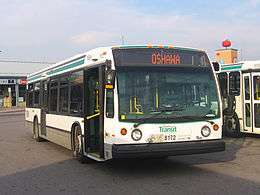
In addition, GO Transit provides the following services within the Region:
- Lakeshore East GO Trains serve Pickering, Ajax, Whitby, and Oshawa GO Stations, providing connections to Toronto's Union Station
- Morning Highway 401 peak hour service to Finch Bus Terminal from Oshawa GO Station via Whitby GO Station, Ajax GO Station and Scarborough Town Centre, with reverse service in the afternoon
- From September to April, weekday express service to the University of Ontario Institute of Technology and Durham College from Scarborough Centre Bus Terminal and additional peak-hour services to and from York University via Brooklin, Brougham, Unionville, and Richmond Hill
- Durham Highway 2/Kingston Road (the former provincial Highway 2) between Pickering and Oshawa is served by buses providing connections to the Toronto Transit Commission at Scarborough Town Centre, York Mills, and Yorkdale Shopping Centre
- Clarington is served by buses connecting with Lakeshore East GO Trains at Oshawa GO Station
- Port Perry in Scugog Township is served by buses from Whitby GO Station
- Uxbridge is served by buses from the Stouffville Corridor
Air travel
Although small airports such as the Oshawa Executive Airport exist in Durham Region, the main airport serving the region is Toronto Pearson International Airport. There is a long-standing proposal for a major new airport in Pickering.
Maritime Infrastructure
Durham Region also has a small maritime industry centered on the Port of Oshawa. The port received around 50 lake freighters per year between 2007 and 2017 and acts as an export terminal for agricultural products from Durham and nearby regions.
Education
The Durham District School Board operates all English-language secular public schools within Durham Region, except for those schools within Clarington, which are part of the Kawartha Pine Ridge District School Board. This is a holdover from the pre-1974 structure in which the area now forming Clarington was part of Durham County, while the other municipalities were part of Ontario County.
The Durham Catholic District School Board operates the separate English-language public Catholic school system within Durham Region, again with the exception of schools in Clarington, which are part of the Peterborough Victoria Northumberland and Clarington Catholic District School Board.
Neither school board is an operating division of the regional government. Instead, as is true of all school boards in Ontario, they are separate entities with distinct but overlapped service areas. Elected public trustees responsible for their operation.
French-language school boards serving the municipality include the Conseil scolaire Viamonde and the Conseil scolaire catholique MonAvenir.
Durham Secondary Academy and Middle School offers private elementary and secondary education for students in the Region of Durham.
The region also is home to Ontario Tech University, Ontario's fastest growing university, Durham College, and Trent University Durham (Trent University's main campus is in Peterborough). The Ontario Tech and Durham College main campuses are located in north Oshawa. Durham College also has a satellite campus in Whitby, and Ontario Tech has one in Downtown Oshawa.
Ontario Tech University is a science, technology engineering and math (STEM)-focused, research driven institution. Ontario Tech is home to the ACE Climatic Wind Tunnel, a research, development and testing facility available for rent to manufacturers of all descriptions, startup companies and researchers in Canada and around the globe. Ontario Tech University is rated number 1 in cross-sector research among Canadian undergraduate universities.[28] Within 15 years of its founding Ontario Tech quickly earned a reputation for computer science, ranking among the top 10 programs in Canada and 4th in Ontario.[29]
Durham College is taking a leading role in one of the fastest-growing industries in the gaming market, through the opening of its Esports Gaming Arena and Mixed-Reality Capture Studio, the first of its kind in Ontario. Durham College Hub for Applied Research in Artificial Intelligence for Business Solutions (the AI Hub) offers industry partners access to technical expertise, state-of-the-art facilities and platforms, and student talent. Durham College Centre for Food is one of Canada's first culinary education facilities that bring the concept of ‘field to fork' to life. Addressing the increasing demand for skilled trades workers, Durham College is home to more than 1,300 skilled trade apprentices, and hosts a number of programs through the Durham College School of Skilled Trades, Apprenticeship & Renewable Technology (START).
Trent University Durham offers full and part-time undergraduate programs, as well as post-graduate certificates. Other key programs at Trent University Durham include Bachelors of Business Administration, Computing Systems, and Communications & Critical Thinking as well as a Master of Management, which is a 16 month professional master program. Trent University Durham announced in 2019 plans to expand their campus in Oshawa to include 200 on-campus residences, creative learning spaces, and state-of-the-art academic space.[30]
Travel region
Durham Region lies within the Central Counties of Ontario, a tourism-related association.[31]
The top tourist attractions in Durham Region include Lake Ontario, Lake Scugog and Lake Simcoe, in particular for fishing. [32] Outdoor activities such as hiking and skiing are popular in the region, in particular in Uxbridge, Ontario, which is the Trail Capital of Canada. Darlington Provincial Park, Jungle Cat World, Parkwood Estate, The Robert McLaughlin Gallery, Canadian Tire Motorsport Park and the Canadian Automotive Museum are other popular attractions.[33]
Tourism is a significant economic sector in Durham Region. Durham Region currently hosts more than four million visitors each year, who spend over $300 million.[34] A casino resort is under development in Durham Region. DLive will include a casino resort, convention centre, film studios, indoor waterpark, cinemas, restaurants, office tower and an amphitheatre.[35]
See also
References
- "Census Profile, 2016 Census Durham, Regional municipality [Census division], Ontario". Statistics Canada. Retrieved October 28, 2019.
- Statistics Canada, Census Profile, 2016 Census: Ontario: Census subdivisions (municipalities)
- "Bowmanville Mostert". Canadian Climate Normals 1981-2010 Station Data. Environment Canada. Retrieved 2016-05-12.
- "Oshawa WPCP". Canadian Climate Normals 1981–2010. Environment Canada. Retrieved 2014-04-12.
- "2016 Community Profiles". 2016 Canadian Census. Statistics Canada. February 21, 2017.
- "2011 Community Profiles". 2011 Canadian Census. Statistics Canada. July 5, 2013.
- "2006 Community Profiles". 2006 Canadian Census. Statistics Canada. March 30, 2011.
- "2001 Community Profiles". 2001 Canadian Census. Statistics Canada. February 17, 2012.
- "(Code 3518) Census Profile". 2011 census. Statistics Canada. 2012. Retrieved 2012-03-01.
- https://www.durham.ca/en/economic-development/the-durham-advantage/community-profile.aspx
- https://www.cbc.ca/news/canada/toronto/pickering-airport-2020-update-1.5402994
- https://www.pickering.ca/en/business/resources/t-e-a/GTA-East-Airport.pdf
- https://www.durham.ca/en/economic-development/industries/energy-environment-and-engineering.aspx
- https://www.durham.ca/en/economic-development/industries/agri-business.aspx
- http://www.omdc.on.ca/collaboration/research_and_industry_information/industry_profiles/Film___TV_Industry_Profile.htm#footnote-b
- https://www.durham.ca/en/economic-development/industries/film-and-television.aspx
- https://www.durhamregion.com/news-story/5690304-cameras-to-roll-in-pickering/
- https://www.durham.ca/en/economic-development/industries/innovative-technology.aspx
- https://www.businesswire.com/news/home/20190806005618/en/360insights%E2%80%99-Channel-Success-Platform%E2%84%A2-Wins-2019-World
- https://www.durham.ca/en/economic-development/the-durham-advantage/education-attainment.aspx
- https://www.durhamregion.com/news-story/9784876-these-are-the-job-sectors-that-have-a-chance-to-flourish-in-durham-over-the-next-20-years/
- https://www.durhamregion.com/news-story/4895878-durham-region-s-top-employers-by-headcount/
- https://media.gm.com/media/ca/en/gm/home.detail.html/content/Pages/news/ca/en/2019/Oct/1022_GM-honours-its-roots-and-prepares-for-the-future.html
- https://www.durham.ca/Modules/News/index.aspx?feedid=06cd0b03-5c85-4c98-b8f4-9bc2fff297b9,afd6c417-383e-4d55-b0ec-43c96d4f448b,07762a62-62cb-46ca-83ee-d849ce531dfa&newsId=a6862e69-fdf6-46ec-a1dc-efe8f3f992cd
- https://www.durham.ca/Modules/News/index.aspx?feedid=06cd0b03-5c85-4c98-b8f4-9bc2fff297b9,afd6c417-383e-4d55-b0ec-43c96d4f448b,07762a62-62cb-46ca-83ee-d849ce531dfa&newsId=a6862e69-fdf6-46ec-a1dc-efe8f3f992cd
- https://www.durham.ca/en/economic-development/the-durham-advantage/access-to-top-talent.aspx
- "Extension of Ontario Hwy. 407, new Hwy. 418 open east of Toronto". On-Site. Retrieved December 11, 2019.
An eastern extension of Ontario Hwy. 407 and a new toll road to connect the lengthened highway to nearby Hwy. 401 opened Dec. 9 on the outskirts of Toronto.
- https://news.ontariotechu.ca/archives/2019/11/ontario-tech-no.-1-in-cross-sector-research-among-canadian-undergraduate-universities.php
- https://www.macleans.ca/education/unirankings/best-computer-science-universities-in-canada-2017-ranking/#gallery/best-computer-science-universities-in-canada-2017-ranking/slide-1
- https://www.trentu.ca/durham/news-events/24281
- "Central Counties Tourism". Retrieved October 29, 2019.
- https://www.durham.ca/en/tourism/fishing.aspx
- https://settlement.org/findhelp/ontario/durham/
- https://www.durham.ca/en/economic-development/industries/strategy.aspx
- https://www.durham.ca/en/economic-development/industries/future-tourism-development.aspx
External links
| Wikimedia Commons has media related to Regional Municipality of Durham. |
- Durham Region Durham Region official site.
- Invest Durham Durham Region Economic Development official site
- Durham Tourism Durham Region Tourism official site
- Durham Region's Official List of Businesses and Organizations

.jpg)

.jpeg)
